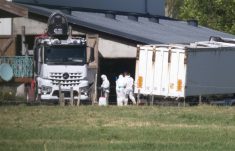The Ontario government’s retreat from slot machines as its primary means of support for horseracing in the province will be covered with a five-year, $400 million funding package.
The province on Friday released its five-year plan for horseracing industry development, which will tie its funding for racetracks to viable business planning and “community and commercial support.”
The $400 million will be allocated not only to individual tracks but to “branding and marketing, responsible gambling, the Horse Improvement Program (HIP), animal welfare and business planning.”
For racetracks, the province said, the funding “will be tied to accountability and transparency measures and will provide a positive return on the investment of public funds.” Eligible tracks will need to provide business cases to receive funding, the province said.
Read Also

U.S. livestock: Cattle fall sharply as Trump says he’s working to lower beef costs
Chicago cattle futures fell sharply on Friday after U.S. President Donald Trump said his administration was working to lower the…
According to the Ontario Horse Racing Industry Association (OHRIA), the province’s plan also has an allotment for rent, to be paid by Ontario Lottery and Gaming Corp. (OLG), for racetracks operating slot machines for the next five years starting in 2014.
Taken together, the five-year government funding available to the industry from rents for OLG slot facilities (estimated at about $102 million a year), the pari-mutuel tax reduction (PMTR, worth about $52 million this year) and the new investment fund will exceed $1 billion, according to the final report from the province’s Horse Racing Industry Transition Panel, on which the province’s plan is based.
The panel also called for continued PMTR funding of HIP, extending the previously announced $30 million-per-year program to March 31, 2019.
“This long-term commitment will create a stable environment for private investment in the industry,” the panel said in its report.
The province’s plan would also see the Ontario Racing Commission (ORC), now mainly a regulatory body, firewalled into separate regulatory and industry development bodies.
The panel had recommended the industry development arm, to be called Ontario Live Racing (OLR), be tasked with providing “overall management of the horseracing industry,” distributing funding and working with OLG on industry development to build up the fan base for racing.
The province on Friday said horseracing will be integrated into OLG’s “modernization plan,” which would include researching “potential horse-themed lottery products” and leveraging the corporation’s “business, marketing and responsible gambling expertise within the horseracing industry.”
“Integrating horse racing with OLG’s modernization will help create a more sustainable industry going forward,” Finance Minister Charles Sousa said in the province’s release. “OLG’s experience in business, marketing and responsible gaming will provide additional benefits to the racing industry.”
Subject to approval from Premier Kathleen Wynne’s cabinet and review by the standing committee on government agencies, Horse Racing Industry Transition Panel member Elmer Buchanan, a former Ontario ag minister, will become chair of the ORC to lead the implementation of the five-year plan.
Buchanan would replace Rod Seiling, the commission’s chairman since 2006. The province on Friday said Seiling is “retiring” from the post, though his appointment as chairman isn’t due to expire until November next year.
“Suffered”
OHRIA on Friday thanked Wynne “for her understanding of the economic importance of the horseracing and breeding industry and her commitment to integrating the horseracing industry into the province’s overall gaming strategy.”
“It has been a very difficult couple of years for the horseracing industry,” OHRIA chair Sue Leslie said in an association release. “Our industry has certainly suffered while negotiations to get to where we are today have taken place.”
The new plan stems from the province’s March 2012 announcement that it would shut down the Slots at Racetracks program (SARP) at the end of March 2013, costing the province’s 18 racetracks funding which was expected to total $340 million in fiscal 2012 alone.
SARP, set up in 1998, was the revenue-sharing agreement between OLG, the province’s racetracks and host municipalities, which allowed government-operated slot machines to be placed at racetrack facilities.
“Looking back on where the industry was in negotiations this time last year, great progress has been made working with Premier Wynne and the Horse Racing Transition Panel,” Leslie said.
“However, there are still many aspects of the report which need further dialogue and clarification, especially in relation to grassroots racing, the survival of racing at Fort Erie Race Track and securing the necessary investment to ensure the breeding industry survives its severe decline.”
OHRIA’s concern for Fort Erie stems from the transition panel’s recommendations on thoroughbred racing. The panel noted Ontario today is home to two thoroughbred tracks, which it said has led to duplication of the expensive infrastructure needed for on-track stabling.
“The best business case for the industry is to consolidate most, if not all, thoroughbred racing at one track — Woodbine,” the panel said in its report to Wynne. “While Fort Erie remains a beautiful and historic site, the panel can find no path to sustainability for a full race calendar there.”
Given capital improvements needed at Fort Erie, the estimated cost of the Fort Erie Live Racing Consortium’s proposal for 40 race days per year at Fort Erie, and the resulting “lost opportunity for higher wagering at Woodbine,” the panel pegged the total cost of a 40-race day year at Fort Erie at $11.4 million.
Those costs would “support a payroll of only $3 million,” the panel said. “In short, the panel can find no path to sustainability for a resident racing program at Fort Erie.”
“Serving public interest”
Among its other recommendations, the panel proposes forming a “standardbred racing alliance to operate a world-class racing circuit within a commercially viable shipping area.” Said alliance, the panel said, would include eight “centrally located” tracks: Hanover, Clinton, Grand River, Western Fair, Flamboro, Georgian, Mohawk and Woodbine.
Along with those tracks, the panel said, “regional tracks provide jobs, racing opportunities for younger and older racehorses and valuable entertainment venues for their communities,” thus it recommends “government support for a coordinated program of regional grassroots racing.”
The panel also endorsed continuing the current 30-race-day calendar of quarter horse racing at Ajax Downs, “supplemented by a limited series of ship-in thoroughbred races.”
The panel further recommended tasking the provincial ag ministry with developing “objectives and benchmarks to measure the industry’s performance in serving the public interest,” with the first such set of metrics to be in place by April 1, 2014.
The panel’s report, which focused on funding to support development of live racing, recommended allotting the new public investment funds to the three breed divisions “based primarily on their contribution to commissions from wagering on live racing.” Tracks would also share the provincewide proceeds from non-track wagering on this basis.
Also, the panel said, “all tracks receiving public funds will be required to invest the net proceeds of new OLG gaming activities into the support of live racing.”
Live racing held within Ontario “generates a stronger economic impact in terms of jobs on the track, on the farm and in related businesses than do simulcasts of races in other jurisdictions,” the panel said. — AGCanada.com Network
Related stories:
Ont. to bring horseracing into province’s games plan, March 11, 2013
Ont. to halt horse racing industry’s slots program, March 12, 2012















